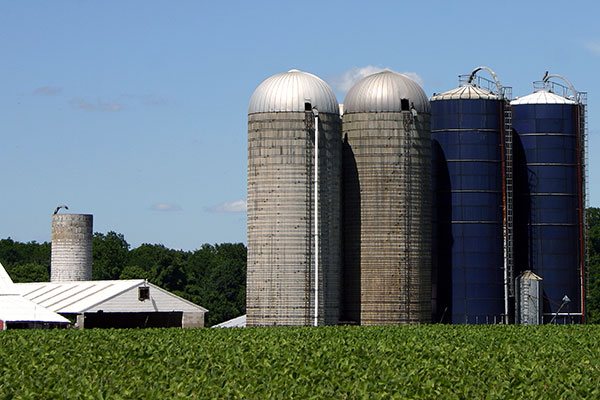A silo is a structure for storing bulk materials. Silos are used in agriculture to store grain or fermented feed known as silage. Silos are more commonly used for bulk storage of grain, food products. Three types of silos are in widespread use today: tower silos, bunker silos, bag silos and silage piles.
1. Tower Silo:
Storage silos are cylindrical structures, typically 10 to 90 ft (3 to 27 m) in diameter and 30 to 275 ft (10 to 90 m) in height. They can be made of many materials such as wood staves, concrete staves, cast concrete, and steel panels. Silos can be unloaded into rail cars, trucks or conveyors.
Advantages;
-
Tends to pack well due to its own weight
-
Lower Storage Losses
-
Requires less area for construction
-
Allows greater mechanization during filling and feedout
-
Convenient to unload in winter
Disadvantages;
2. Bunker Silo:
Bunker silos are trenches, usually with concrete walls, that are filled and packed with tractors and loaders. The filled trench is covered with a plastic tarp to make it airtight.
Advantages;
-
Holds large capacity
-
Can be filled with conventional farm equipment
-
Offers faster unloading rates
-
Forage quality changes occur gradually if filled using the progressive wedge
-
Inexpensive
-
Well suited to very large operations.
Disadvantages;
-
Higher initial cost
-
Requires greater care in filling and packing
-
Will not work for smaller herds
-
Need usually unloading with a tractor and loader.
3. Silo Bags:
Bag silos are heavy plastic tubes, usually around 8 to 12 ft (2.4 to 3.6 m) in diameter, and of variable length as required for the amount of material to be stored. They are packed using a machine made for the purpose, and sealed on both ends.
Advantages;
-
Lower capital investment
-
Flexible storage system
-
Feed is easily inventoried
-
Can be used for small and large herds
-
Fewer safety and health hazards
-
Lower Storage Losses
Disadvantages;
-
Specialized equipment may be needed
-
Plastic disposal creates extra labor and environmental concerns
-
Bags must remain intact, compromised bag can result in a complete loss
4. Silage Piles:
A silage pile is constructed by unloading silage into an elevator and piling up the silage, much as a quarry piles sand or gravel.
Advantages;
-
Inexpensive
-
Good for short term storage needs
Disadvantages;
-
Large amount of exposed surface area
-
Greatest loss of dry matter during storage
-
More difficult to pack
Web Segments:
https://fyi.extension.wisc.edu/cwas/files/2010/07/ForageStorageOptions.pdf
https://fyi.extension.wisc.edu/forage/drive-over-silage-pile-construction/

